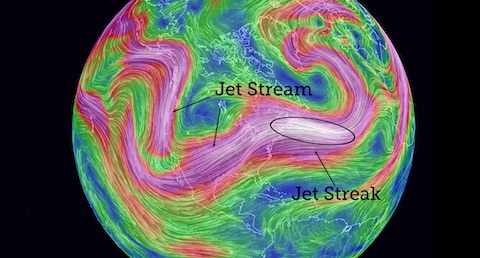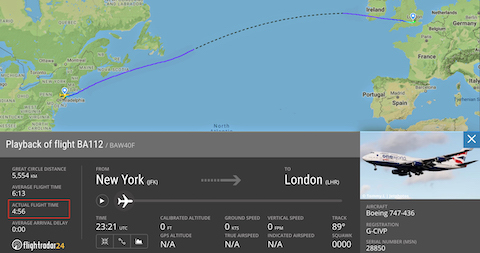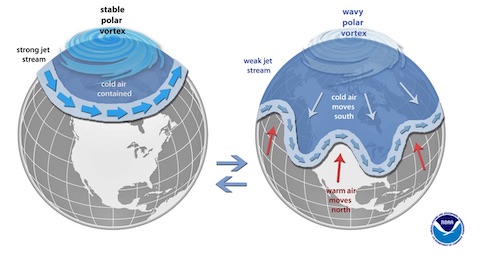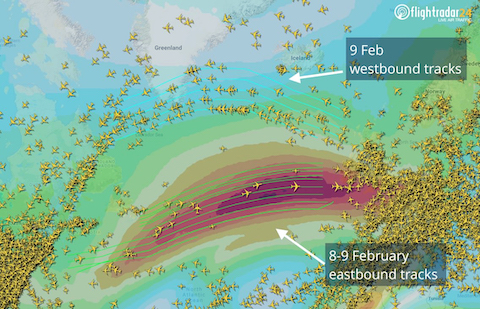
Credit: WeatherSTEM
When passengers boarded a British Airways flight from New York to London on February 8, 2020, they had no idea they were about to make history.
Once their 747 reached cruising altitude, the pilots directed the plane into a jet streak, a fast-moving current of air that sometimes occurs in winter.
The streak rocketed the plane to a ground speed of 825 miles an hour, cutting travel time by 25 percent and setting a record for subsonic aircraft making the trip.
The surprised passengers arrived in London in less than 5 hours—an hour and 40 minutes ahead of schedule.
One hundred EarthDate episodes ago we talked about the jet stream, the west-to-east currents of air that circle the globe.
It’s common in winter for the Northern Polar Jet to drift southward into what pilots call the North Atlantic Tracks, the routes they fly from the U.S. to Europe.
When other factors, like a storm system, increase its velocity, the jet stream can create jet streaks—rivers of wind more than twice as fast, at up to 250 miles an hour, like the one that carried that February 2020 flight.
Faster trips like these save time and fuel and reduce exposure to cosmic radiation for passengers and crew, which happens on any flight.
So, if you’re looking for a quick, efficient, safe trip to Europe—and your own chance to land in the record books—plan one for a stormy winter night… but don’t plan to sleep!
Background
Synopsis: In February 2020, weather conditions were just right to create a strong eastward-directed jet stream that provided a tailwind for BA Flight 112 from New York to London. The flight broke previous records, travelling at about 825 mi (1327 km) per hour. Earth helped the aircraft to achieve that record-setting speed.
- On February 8, 2020, British Airways Flight 112 departed Kennedy Airport in New York City at 6:47 PM. It landed at Heathrow Airport in London on February 9 at 4:43 AM, just 4 hours and 56 minutes later—a record for a subsonic commercial airliner transatlantic trip.
- The average time required for the flight is 6 hours 13 minutes, and the flight is normally scheduled for 7 hours and 5 minutes to include taxi time and delays.
- Travelers on this 747-400 arrived 1 hour and 38 minutes earlier than normal for the 3451 mi (5554 km) flight.

Credit: FlightRadar24.com
- In the winter, the polar jet stream often dips southward into the region of typical North Atlantic routes followed by jetliners when they reach cruising altitudes of around 30,000 ft (9144 m), resulting in eastbound speed records along this route. The February 2020 event was exceptional, however. It was associated with powerful Storm Ciara that pummeled Northwestern Europe.
- The British Airways pilots directed the plane along a particularly strong part of the polar jet stream, called a jet streak, that provided a tailwind of up to 260 mi (418 km) per hour.
- The tailwind boosted the plane’s velocity of 565 mi (909 km) per hour to a ground speed of 825 mi (1327 km) per hour for 24 minutes off the coast of Newfoundland.
- That same night, Virgin Atlantic Flight 4 from Kennedy Airport to London Heathrow made its trip in 4 hours 57 minutes. The Airbus 350-1000 travelled at similar speeds with only two engines compared to the four engines of the 747-400 used to complete the British Airways flight.

Credit: NOAA
- We talked about Earth’s various jet streams in a previous EarthDate episode.
- Jet streams are narrow bands of fast-moving air in the upper atmosphere at the intersections of Earth’s huge atmospheric circulation cells. These cells are set up by solar radiation and planetary rotation.
- Jet streams flow west to east between high- and low-pressure systems, pushing around the systems and driving along weather.
- The strongest jet stream is the polar jet, which occurs at lower altitudes than other jets, where airliners can take advantage of it.
- Differences in temperature between the Arctic polar air cell and warmer air cells to the south power the polar jet stream and control its path, intensity, and speed.
- Typical transatlantic jet stream velocities clock in at 110 mi (177 km) per hour. As seasoned travelers know, for a transatlantic flight, this shortens eastbound flights by about an hour while lengthening westbound flights by an hour.
- Previous records have been broken successively for the past 3 years.
- On January 14, 2018, a 787-9 Dreamliner, Norwegian Airlines DY7014, traveled from New York to London Gatwick in 5 hours and 13 minutes, arriving 53 minutes ahead of schedule. A 202 mi (325 km) per hour tailwind had increased the plane’s ground speed to 776 mi (1249 km) per hour.
- On February 18, 2019, the jet stream clocked in at 231 mi (372 km) per hour, the fastest on record at that time since 1957. Another 787 Dreamliner, Virgin Atlantic Flight 8, was on its way from Los Angeles to London and reached a ground speed of 801 mi (1289 km) per hour over Pennsylvania.
- Faster travel times like these reduce cosmic radiation exposure for passengers and crew by about 30%.

Credit: FlightRadar24.com
- The speed of sound is 767 mi (1234 km) per hour, but these recent record-breaking flights were not supersonic, even though they had ground speeds faster than 767 mi per hour.
- Aircraft track their location and ground speed using satellite navigation and periodically broadcast this information using automatic dependent surveillance-broadcast (ADS-B) technology. They may also broadcast indicated airspeed, true airspeed, and Mach value.
- Mach 1 is the breakover from subsonic to supersonic—the point at which an object exceeds the speed of sound and will generate a sonic boom.
- The aircraft data for British Airways Flight 112 showed that although the plane’s speed was 825 mi (1327 km) per hour, it traveled at a Mach value of 0.86. This apparent discrepancy occurs because the speed of sound is relative to the speed of the air mass surrounding the aircraft, and the jet streak was moving very fast also.
- As it turns out, most commercial jetliners cruise at 70–85% of the speed of sound relative to their surrounding air masses.
- Supersonic travel occurs in military jets today, but from 1969 to 2003 there was a successful supersonic commercial aircraft—the Concorde—that leaves all these records in the dust.
- The Concorde set the New York to London commercial jetliner speed record of 2 hours and 53 minutes on February 6, 1996, travelling at top ground speeds of 1350 mi (2173 km) per hour.
- The Concorde program shut down in the aftermath of a terrible crash on July 25, 2000. Just after an Air France Concorde took off for a Paris to New York flight, it stalled and crashed into a hotel, killing all 109 passengers and crew as well as 4 people on the ground. All Concordes were immediately grounded and the program was shut down in 2003.
- Recently, aircraft developers have been considering supersonic aircraft designs that would increase safety and decrease the impact of sonic booms, which had been another major problem for the Concorde program.

